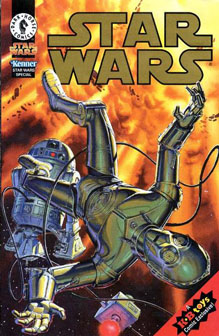If you’ve read Dark Horse’s reprints of the 1979-84 newspaper strips – “Classic Star Wars: The Early Adventures” (writer and artist Russ Manning), “Classic Star Wars: Han Solo at Stars’ End” (writer Archie Goodwin and artist Alfredo Alcala) and “Classic Star Wars” (Goodwin and artist Al Williamson) – you can knock most of the newspaper strips off your checklist. But not all.
Three whole stories, plus three more oddities, went unpublished (or uncollected, in the case of “The Constancia Affair” – meaning it was published as an individual issue but not collected in a trade paperback or omnibus) by Dark Horse, but thanks to the wonderful Daily Star Wars blog, you can at least read them.
For whatever reason, Dark Horse reprinted the very first Manning story, the Sunday-only “Constancia Affair,” exclusively as a Kay-Bee Toys comic in 1998 (pictured above), making it rare enough that as I type this the lowest price for it on eBay is $45. Manning’s second Sunday-only arc, “The Kashyyyk Depths,” went completely unpublished by Dark Horse, as did “Planet of Kadril,” which was written by Russ Helm with art by Alcala.
The never-published-on-the-funny-pages work includes the start of an “A New Hope” adaptation by Williamson; a deleted sequence from Manning’s longest story, “Gambler’s World”; and a handful of panels from Manning’s unfinished story about Luke needing to save Leia from Tusken Raiders.
In chronological order, let’s take a closer look at these tales, which rank as some of the most obscure in “Star Wars” lore:
Williamson’s unfinished “A New Hope” adaptation (1979)
Before he changed his mind and decided he couldn’t devote time to both “Star Wars” and “Secret Agent X-9,” Williamson produced 12 daily panels adapting the movie, up through the “Look sir, droids!” scene (He changes the dialogue to “From the tracks, it appears to be droids!”). It seems odd that the L.A. Times Syndicate considered adapting the film to kick off its “Star Wars” strips, but I suppose it was a different time back then, before the age of home video.
Still, “Episode IV” had been adapted in the best-selling Marvel Comics and the best-selling novelization, and the film was regularly re-released in theaters. So it makes sense that when the Syndicate hired Manning to replace Williamson, they decided to let him create original tales. (On the other hand, “A New Hope” would be adapted to comics two more times: A 1997 Special Edition version, and a 1998 Manga version.)
“The Constancia Affair” (1979)
The very first “Star Wars” newspaper strip to see print was not given a title until Dark Horse’s Kay-Bee exclusive. It consists of 18 Sunday strips, and runs for 12 pages in the Kay-Bee comic. Since I don’t own it, I can’t be sure, but presumably Dark Horse used the same method as on their “Classic Star Wars” series of deleting redundant panels for the sake of flow.

As I noted in my review of “The Early Adventures,” Manning’s art is respectable, but his writing is mediocre to god-awful. That having been said, “Constancia” and “The Kashyyyk Depths” are among his least-bad stories. My theory for why they didn’t make the “Early Adventures” cut is that they didn’t hit the standard 24-page count. Since “Kashyyyk” was nine Sunday strips long, that equates to six pages, and a total of 18 pages when combined with “Constancia’s” 12 pages. Even if the other six pages were advertisements, a lot of “Star Wars” completists would’ve been happy just to own these stories.
But enough dreaming about what never was. As is the case on all Manning strips, “Constancia” is packed with seemingly apocryphal elements: We are told that Luke is the son of Master and Mistress Tan Skywalker, that C-3PO was activated centuries ago on the planet Affa, and that Darth Vader’s advanced TIE fighter is not so unique – run-of-the-mill Imperials use ships of that design, too. Enter the ret-conners: “Tan” is a title given to elite pilots, and Affa features a Cybot Galactica plant that makes protocol droids. And I suppose it’s possible that a few other TIE advanced fighters could exist. Maybe they were part of an imperfect batch, and utilized on obscure missions such as this one.
Manning makes the same mistake that artist Howard Chaykin did on “The Keeper’s World” (for Pizzazz magazine): He puts a TIE fighter on steroids and re-imagines it as an “Imperial landing craft” that’s equally spacious as the Millennium Falcon. (Walt Simonson would later draw a ‘roided-out Y-wing in Marvel Issue 49.) Manning’s ship looks a lot like a TIE bomber, which is intriguing because that ship wasn’t introduced until “The Empire Strikes Back” the following year.
In “Constancia,” Han and Chewie fly around with a woman named Gyla, who at first seems to be a random space babe that Han picked up as if he was the outer-space version of Bob Falfa from “American Graffiti” (which he kind of is, but still).
According to Rich Handley’s article in Star Wars Galaxy Collector Issue 3 (August 1998), Manning featured Han and Chewie in the first two Sunday strips and featured Luke and Leia in the concurrent daily strip, “Gambler’s World,” to make it clear to readers that these were separate narratives. (After “Gambler’s World,” Manning told one story at a time, seven days a week. And fortunately for “The Early Adventures,” each fit nicely into a 24-page comic.)
This untitled arc was given a name by “Star Wars” scholar Jason Fry. Although the framing mechanism of C-3PO giving a report to cavern-sized Rebel Alliance computer Mistress Mnemos takes place after “Constancia,” the story itself takes place before it.
Manning serves up a more detailed look at the Wookiee homeworld than we were privy to in 1978’s “Star Wars Holiday Special,” as we learn that no one dares go below “the eighth level.” While later stories did bring the action all the way down to the planet’s surface (and “Episode III” featured a patch of the world that isn’t tree-shrouded), the idea of increasing danger as you go farther down on Kashyyyk was retained in the lore.
In this story, we learn that Gyla was an Imperial scientist before she absconded with Han. In talking to Mnemos, C-3PO suggests that Han has reason to suspect that Gyla is an Imperial spy, but this thread is never picked up on.
Deleted scene from “Gambler’s World” (1979)
In these four unpublished daily strips, Luke and Leia ride a really scary roller coaster.
Unfinished Luke/Tusken Raider story (1979)
Like his last-published story, “Frozen World of Ota” (which was finished by Manning’s assistant, Rick Hoberg), the Tusken Raider story went uncompleted by Manning due to his failing health and death. It consists of six daily strips and seems to take place in the middle of a larger story, as Luke speaks of Leia having been kidnapped by Tusken Raiders.
It’s notable for the similarity to “Episode II” (where Shmi is kidnapped by Raiders), the use of “sandmen” as an alternate name for the creatures, and for the final strip, which finds Luke perched over an unconscious Tusken, saying “I’m going to be the first human in 200 years to see what a Tusken Raider looks like … under his mask!” It would take until the “Republic” comics two decades later before we’d actually see an unmasked Tusken, although since Sharad and A’Sharad Hett are both humans who were adopted into Tusken culture, perhaps we still don’t know what a traditional Raider looks like. If so, that’s a helluva cliffhanger, Russ.
This story by Helm, who co-wrote “Princess Leia: Imperial Servant” and “The Second Kessel Run” with Manning, ranks on the short list of the worst “Star Wars” tales ever told. Covering nearly three months of dailies and Sundays in late 1980, it is interminable, repetitive, nonsensical and almost entirely absent of action scenes. Darth Vader uses pacifog as a mind-control stimulant to get the denizens of Kadril to gather up all of the planet’s loose rocks for him, because the rocks have special technological powers. Luke, Leia and Han are prominently featured, but don’t do much of anything.
From a critical standpoint, I can guess what went wrong: Helm and Alcala let “Kadril” unfold in a stream-of-consciousness style and never grasped where it was going, especially as the story got longer and longer.
I don’t blame Dark Horse for skipping this one: Because “Planet of Kadril” would’ve taken up multiple comic issues, and because it has no value other than as a historical curiosity for die-hard fans, it could’ve delivered a blow to the line’s overall reputation.
That having been said, I’m glad Daily Star Wars gives us a chance to read it (or at least the start of it, before you throw your hands up in frustration). As a critic, I prefer good “Star Wars” – and “Planet of Kadril” is not remotely in the ballpark of good — but as a “Star Wars” fan I love ALL “Star Wars.”
(Note: In a previous version of this post, I wrongly credited Archie Goodwin for writing “Planet of Kadril,” under the old myth that Russ Helm was a pseudonym. However, Helm is a real person, as revealed in Star Wars Insider Issue 141. Thank you to the Daily Star Wars Blog for the correction.)
Comments
![]() Hey John, thanks for being a fan of the blog! I thought I’d pop in and clear up a common misconception that was only just recently discovered.
Hey John, thanks for being a fan of the blog! I thought I’d pop in and clear up a common misconception that was only just recently discovered.
For years it was thought that Russ Helm was a pseudonym for Archie Goodwin. However it turns out that was not the case.
In Star Wars Insider 141 Michael Kogge did an interview with Lucasfilm’s Lindsay Smith where she revealed that Russ Helm was an artist friend of hers that she hired to help write the strip during its transition period.
I was as surprised as anyone! Anyway, great article. =)# Posted By Daily Star Wars | 11/14/14 2:46 PM
![]() Thanks for reading, and for the correction. I read SW Insider cover-to-cover every month, but I must’ve forgot about that tidbit and my brain reverted back to the outdated information when I wrote this post. It makes a lot more sense now, as “Planet of Kadril” does not remotely resemble Manning’s SW work.# Posted By John Hansen | 11/14/14 5:32 PM
Thanks for reading, and for the correction. I read SW Insider cover-to-cover every month, but I must’ve forgot about that tidbit and my brain reverted back to the outdated information when I wrote this post. It makes a lot more sense now, as “Planet of Kadril” does not remotely resemble Manning’s SW work.# Posted By John Hansen | 11/14/14 5:32 PM

